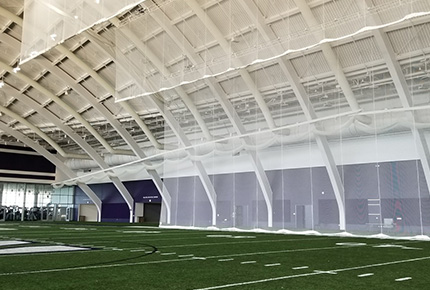Indoor and outdoor athletic facilities have different requirements when it comes to netting. What works for one setting may not work for the other. That’s why it’s important to consider the following factors when selecting sports netting for your application.

Type of Material
The most common types of sports netting include:
Nylon: This material is good for indoor sports netting because it can withstand heavy use while retaining elasticity. It isn’t ideal for outdoor fields and stadiums as it’s susceptible to moisture, shrinking and discoloration.
Polyester: This UV-resistant synthetic material can endure extreme temperatures and abrasion, making it ideal for outdoor sports netting. It’s a cost-effective option that offers long-term savings if it’s maintained properly.
Polyethylene: The high tensile strength of polyethylene netting is good for indoor and outdoor use. This material can tolerate heavy impacts from objects like hockey pucks, baseballs and volleyballs. It’s inexpensive and UV resistant.
Environmental Considerations
Indoor sports netting doesn’t have to be sun or weather resistant since it’s used in a controlled climate. Moisture and UV resistance are essential for outdoor sports netting. Snow, wind, rain and ice weaken soft fibers and cause fraying. You need to consider the net material and mesh size when selecting athletic netting for outdoor facilities to ensure it can sustain wear and tear.
Durability
Netting break strength is how much tension fibers can handle before breaking. The higher the break strength, the stronger the sports netting. Indoor and outdoor sports netting must have substantial durability to protect spectators, players and equipment during practices and games.
Safety and Performance
High-impact absorption is a necessary feature for indoor netting to minimize the risk of injury. The same is true for outdoor sports netting systems, which is why twine size plays an essential role in finding the right solution.
Twine size can determine sports netting performance and how well it handles impacts over time.
It’s available in the following categories:
- #15: Good for batting cages and can last two to four years
- #21: Stronger fibers that last about 5 years
- #30: Durable enough to withstand moderate use for four to six years
- #36: Commercial quality fibers designed for heavy use over several years
- #42 and higher: Professional grade with a maximum lifespan based on use
Installation and Maintenance
The controlled climate of indoor sports facilities reduces necessary maintenance to keep your nets in working condition. Outdoor sports netting requires regular inspection, cleaning and proper storage in the off-season.
Outdoor netting typically requires an additional support structure during installation, whereas indoor netting attaches to preexisting beams, walls and ceilings.
You may require customization for indoor sports netting depending on the dimensions of your venue. An indoor system might also mandate custom mounting to suit architectural obstacles.
Sports Netting from Tiffin Scenic Studios
Find the custom athletic netting and rigging solutions based on your unique application at Tiffin Scenic Studios. We design and manufacture all sports netting in-house and offer inspection and installation services. Contact our team to request a consultation.